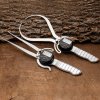odie
TOTW Team
- Joined
- Dec 22, 2006
- Messages
- 7,116
- Likes
- 9,818
Just wondering if anyone here has a Tompkins Gage'T Thickness Gauge, and would like to comment on this device used to measure wall thickness of bowls.
There is a video available on this product here:
http://www.woodturnerscatalog.com/p...ge%27T-Thickness-Gauge?term=gage't+wall+gauge
Pay particular attention to the method used to "sweep" a bowl wall between foot and rim, and how that may apply to give a turner an overall "visual" feeling for the entire surface.
At $70, it's a rather expensive option, but if it saves a few bowls.....the cost can be absorbed very quickly.
My interest is for thin wall bowls, and have always used calipers to test for wall thickness. There is no real problem with calipers......they are accurate and work well, but only give measurements at a single point without making a manual adjustment.....and the steel legs can mar a finely finished surface rather quickly, if not very carefully handled.
So tell me......is the Thompkins Gage'T a break-through innovation.......or, just one more woodturning gadget that doesn't live up to it's claims?
ooc
There is a video available on this product here:
http://www.woodturnerscatalog.com/p...ge%27T-Thickness-Gauge?term=gage't+wall+gauge
Pay particular attention to the method used to "sweep" a bowl wall between foot and rim, and how that may apply to give a turner an overall "visual" feeling for the entire surface.
At $70, it's a rather expensive option, but if it saves a few bowls.....the cost can be absorbed very quickly.
My interest is for thin wall bowls, and have always used calipers to test for wall thickness. There is no real problem with calipers......they are accurate and work well, but only give measurements at a single point without making a manual adjustment.....and the steel legs can mar a finely finished surface rather quickly, if not very carefully handled.
So tell me......is the Thompkins Gage'T a break-through innovation.......or, just one more woodturning gadget that doesn't live up to it's claims?
ooc


